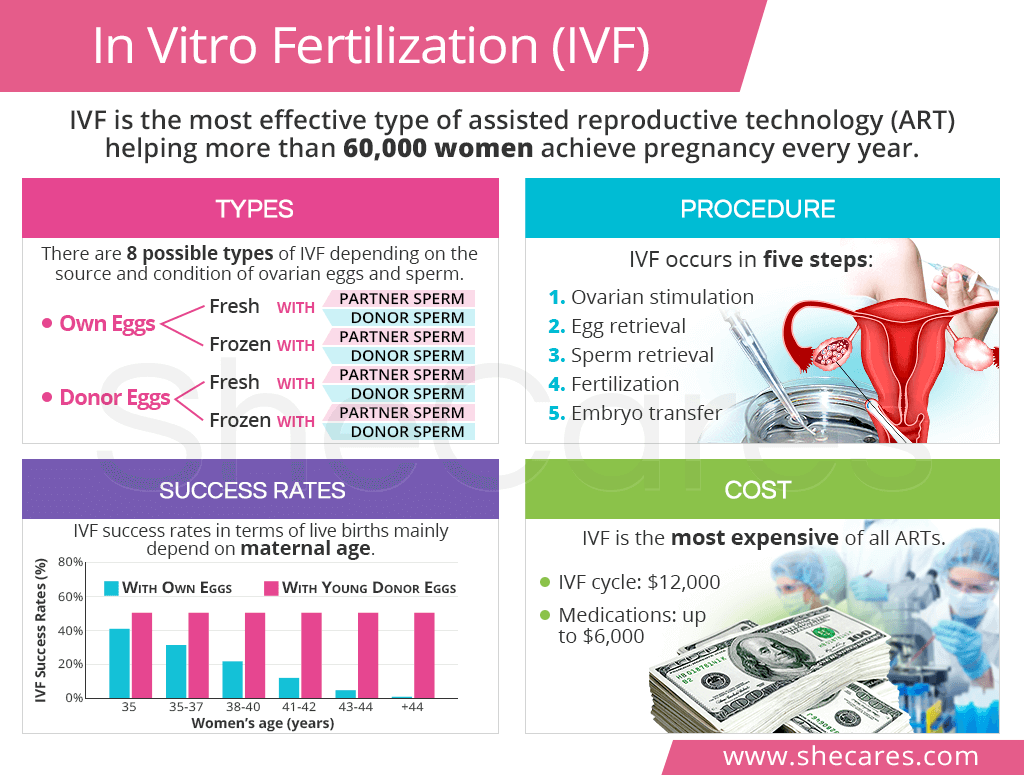What is In Vitro Fertilization?
IVF Meaning
The words “in vitro” come from Latin and mean “in glass,” while “fertilization” refers to the union of the sperm with the egg. In other words, in vitro fertilization signifies conception that takes place outside of a woman's body.
Reasons for IVF
IVF enables women to get pregnant when natural pregnancy is difficult or even impossible due to the following factors:
Poor ovarian reserve
Premature ovarian failure
Uterine fibroids
Blockage or loss of the fallopian tubes
Male factor infertility
Genetic disorders
Postmenopause
IVF can also be a part of fertility preservation, a process of prolonging a woman's fertility for the future through oocyte or embryo cryopreservation, or egg freezing.
Types of IVF
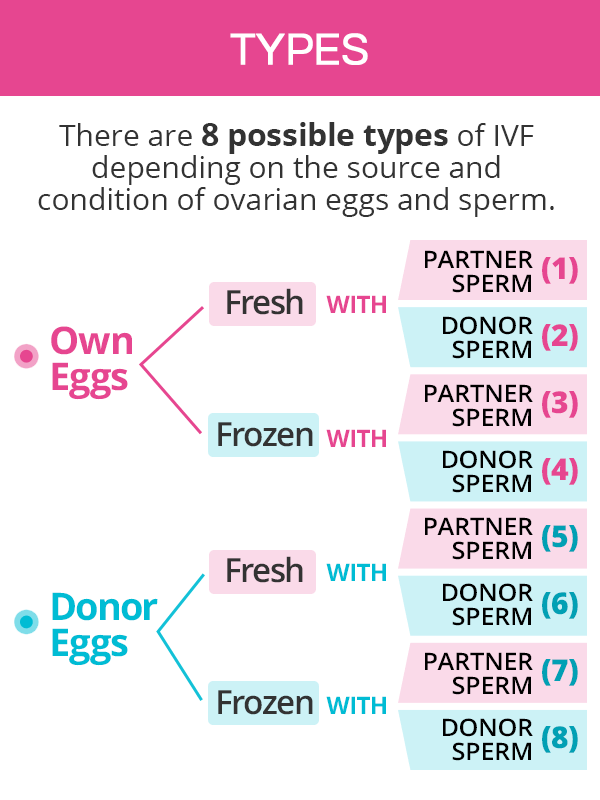
There are 8 possible types of IVF, and they're represented by a combination of the following variables pertaining to the source and condition of ovarian eggs and sperm:
- Own fresh eggs with partner's sperm
- Own fresh eggs with donor's sperm
- Own frozen eggs with partner's sperm
- Own frozen eggs with donor's sperm
- Donor fresh eggs with partner's sperm
- Donor fresh eggs with donor's sperm
- Donor frozen eggs with partner's sperm
- Donor frozen eggs with donor's sperm
Determining which Type of IVF to Undergo
Whose Eggs to Use
Women usually decide to undergo donor egg IVF when their own eggs are not sufficient in number or quality, or if they had their ovaries removed in the past.
IVF with Own Eggs
A woman's ovaries are stimulated to mature more eggs, which will be harvested and fertilized.
Harvested eggs might also be frozen for future use.
IVF with Donor Eggs
Egg donors are screened for hereditary diseases and sexually transmitted diseases (STDs).
Donors undergo ovulation stimulation to mature a sufficient number of eggs for harvesting.
Whose Sperm to Use
Besides personal choices, donor sperm can be used when a woman's partner has sperm abnormalities that prevent natural conception or a genetic condition that might be passed down to children.
IVF with Partner's Sperm
- Sperm is obtained by a woman's partner on the day of IVF through masturbation.
IVF with Donor Sperm
Sperm can be provided from a known or an anonymous donor via a sperm bank.
In both cases, the sperm sample is tested for STDs and genetic conditions.
Whether to Use Fresh or Frozen Eggs
A woman has a choice to use eggs that have been freshly harvested or those that have been cryopreserved, or frozen, with the intention to be used in the future.
Fresh Eggs IVF
If using own eggs, all IVF steps are completed with one cycle. Unused eggs or embryos (fertilized eggs) can be frozen.
To use fresh donor eggs, women's cycles have to be synchronized with IVF medications.
Frozen Eggs IVF
If using own eggs, the process is similar to a fresh cycle, except that the eggs are already harvested and have to be thawed first.
Frozen donor eggs are provided by a fertility clinic.
IVF Procedure
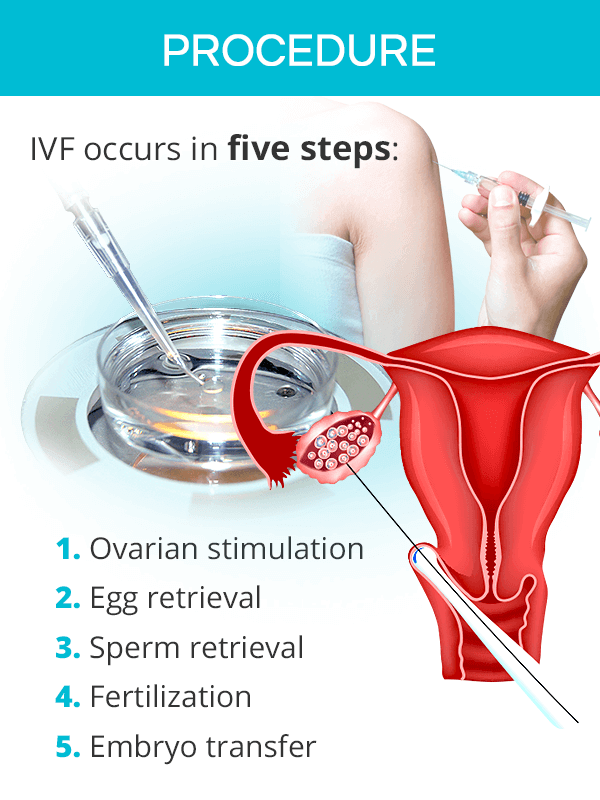
One in vitro fertilization cycle takes about six to eight weeks. A typical IVF step-by-step procedure using one's own fresh eggs occurs in the following way:
Ovarian stimulation. To obtain more viable eggs, the ovaries are stimulated with synthetic hormones to mature multiple eggs. It usually takes 7 to 14 days for the eggs to be ready for retrieval.
Egg retrieval. Matured eggs can be retrieved from the ovaries about 36 hours after the completion of the ovarian stimulation regimen. The most common method is called transvaginal ultrasound aspiration.
Sperm retrieval. On the day of egg retrieval, sperm is collected from the partner through masturbation, or donor sperm will be obtained. Once collected, sperm is prepared for fertilization.
Fertilization. Fertilization can happen either by mixing healthy sperm with healthy eggs (called insemination) or by injecting a single sperm directly into a mature egg, called intracytoplasmic sperm injection (ICSI).
Embryo transfer. Two to five days after fertilization, the embryos are transferred to the uterus. Nowadays, only one embryo is typically transferred, though two or more might be moved to increase the chances of implantation.
IVF Success Rates
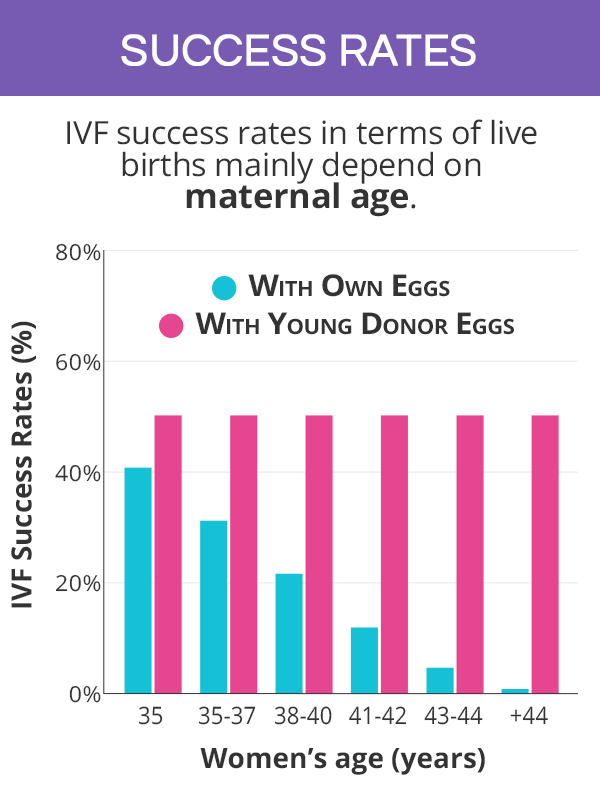
Maternal age is the most important factor affecting female fertility and IVF success, though other factors, like the underlying cause of infertility, levels of stress, unhealthy addictions, or a woman's weight, also play a big role.
It is important to make a distinction between pregnancy rates and live birth rates as some women who conceive through IVF will miscarry and not carry the pregnancy to full term. As such, live birth rates are the best representation of IVF success rates:
IVF Success Rates by Age with Own Eggs
Because ovarian reserve decreases with age, IVF success rates with own eggs drop as a woman ages:
- Women under 35: 41-43%
- Women 35-37: 33-36%
- Women 38-40: 23-27%
- Women 41-42: 12-14%
- Women 43-44: 5%
- Women over 44: 1%
IVF Success Rates by Age with Young Donor Eggs
The uterus does not age as the ovaries do. So, IVF success rates with donor eggs remain steady across age groups:
- Women under 35: 48-51%
- Women 35-37: 48-51%
- Women 38-40: 48-51%
- Women 41-42: 48-51%
- Women 43-44: 48-51%
- Women over 44: 48-51%
IVF Risks & Side Effects
IVF Side Effects
IVF is generally a safe and minimally invasive procedure. Mild and brief post-procedure reactions might include light cramping, bloating, small discharge, or breast tenderness.
The occurrence of heavy bleeding, blood in the urine, or fever calls for immediate medical attention as it might be a sign of infection. Rarely, IVF medications can cause ovarian hyperstimulation syndrome (OHSS), leading to ovarian swelling and pain. In most cases, OHSS resolves within a week.
IVF Risks
Multiple gestation is the main IVF risk. The chances of conceiving twins with IVF are high, about 40%, if two embryos are transferred and 1.6% if only one embryo is placed in the uterus. Multiple pregnancies are at a higher risk of premature birth or low birth weight.
Moreover, IVF is known to be an emotionally draining process due to high stress levels and finances, among other factors. As such, women undergoing IVF are at a higher risk of depression and anxiety, especially with repeated unsuccessful cycles.
IVF Cost
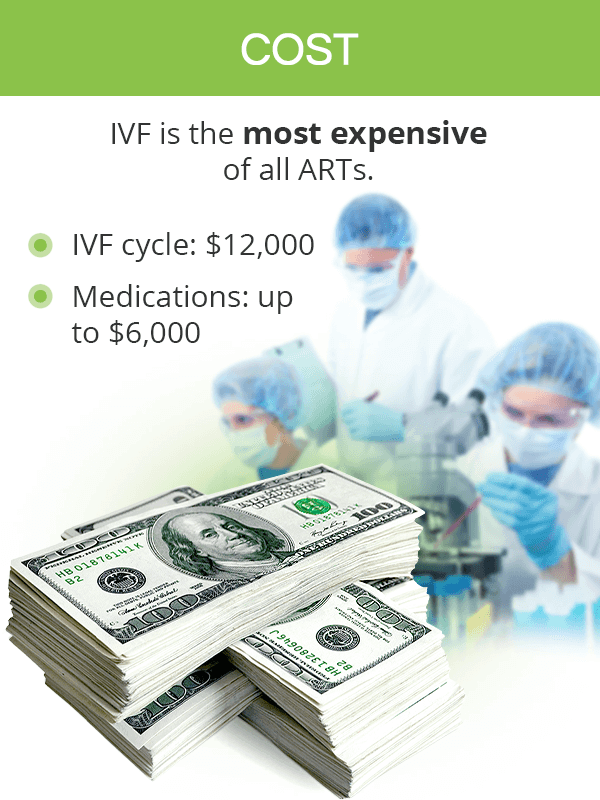
IVF is the most expensive method of achieving pregnancy. Although some U.S. states require insurance companies to provide partial coverage, in many cases, couples are forced to cover the entire cost out of pocket.
There are several components to an average IVF cost per cycle, such as:
IVF cycle (egg harvesting, fertilization, and transfer): $12,000
Medications for ovarian stimulation: $1,000 - 6,000
Additional costs might include a pre-implantation genetic diagnosis (PGD) used to detect genetic disorders, of which the parents are carriers; the cost of egg freezing and storage fees if IVF pregnancy is desired at a later time; and the expenses involved in obtaining donor eggs, embryos, or sperm.
Key Takeaways
Without a doubt, in vitro fertilization is an effective and – often - the only viable technique for many couples that struggle to get pregnant naturally. However, it is also known to be difficult in terms of emotions, stress, and finances. Depending on maternal age and the underlying reason for fertility problems, women can choose to undergo IVF with their own or donor's eggs; use their partner's or donor's sperm; and decide to get pregnant using fresh or frozen eggs.
Among all available ARTs, IVF success rates are the highest, about 40% for women under 35 using their own eggs. Because fertility and age are tightly related, the rates of live births decrease to 1% by the time a woman reaches her mid-40s. However, studies have found that those using younger donor's eggs have steady rates of success across age groups, equating to about 51%. This generally safe and minimally invasive procedure comes with high financial costs, which can easily exceed tens of thousands of dollars.
Sources
- American Pregnancy Association. (2009). Donor Eggs. Retrieved March 21, 2019 from https://americanpregnancy.org/infertility/donor-eggs/
- American Pregnancy Association. (2019). In vitro fertilization: IVF. Retrieved March 21, 2019 from https://americanpregnancy.org/infertility/in-vitro-fertilization/
- CDC. (2019). Assisted Reproductive Technology (ART). Retrieved March 21, 2019 from https://www.cdc.gov/art/index.html
- Mayo Clinic. (2018). In vitro fertilization (IVF). Retrieved March 21, 2019 from https://www.mayoclinic.org/tests-procedures/in-vitro-fertilization/about/pac-20384716
- Medline Plus. (2019). In vitro fertilization (IVF). Retrieved March 21, 2019 from https://medlineplus.gov/ency/article/007279.htm
- Therapeutics and Clinical Risk Management. (2006). In vitro fertilization (IVF): a review of 3 decades of clinical innovation and technological advancement. Retrieved March 21, 2019 from https://www.ncbi.nlm.nih.gov/pmc/articles/PMC1936357/
